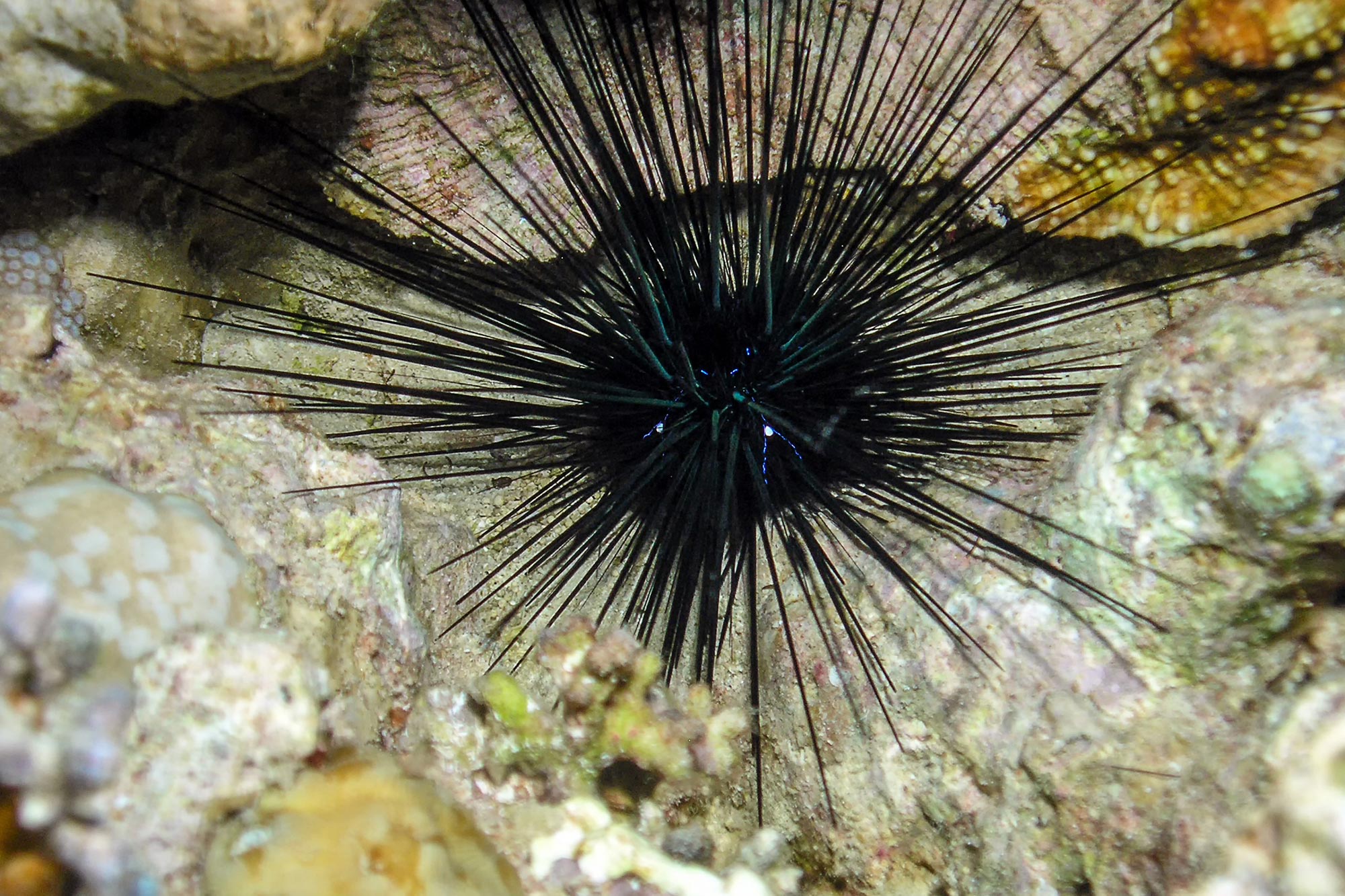
Одноклеточный организм, scuticociliate, был идентифицирован как причина массовой гибели длинноиглых морских ежей в 2022 году в Карибском море и на восточном побережье Флориды. Эти морские ежи необходимы для здоровья коралловых рифов, и открытие поднимает вопросы о присутствии инфузорий, условиях их роста и их потенциальном влиянии на другие виды. Фотография длинного колючего морского ежа (Diadema antillarum).
Массовая гибель морского ежа с длинными иглами — потеря, которая угрожает здоровью коралловых рифов от Карибского моря до восточного побережья Флориды, — была вызвана одноклеточным организмом, называемым инфузорией.
В 2022 году закончилась охота на убийцу, который уничтожил длинноиглых морских ежей в Карибском море и вдоль восточного побережья Флориды. Группа исследователей, организованная Мией Брейтбарт, заслуженным профессором Колледжа морских наук Университета Южной Флориды, определила одноклеточный организм, называемый ресничкой, как причину массовой гибели морского животного, жизненно важного для здоровья коралловых рифов.
Их выводы опубликованы 19 апреля в журнале Nature.
Ciliate culture viewed under the microscope. Credit: Mya Breitbart USF College of Marine Science
“We’re beyond thrilled to get to the bottom of the 2022 mystery and a bit stunned we did it so quickly,” said Breitbart, senior author on the Science Advances study and an expert in marine genomics. “We had a great team in place and the tools needed to do the ocean science equivalent of a forensic investigation.”
Ciliates are microscopic organisms covered in hair-like structures called cilia that help them move and eat. They are found almost anywhere there is water and most are not disease-causing agents. However, this specific species of ciliate – called a scuticociliate – has been implicated in die-offs of other marine species, such as sharks, in the past.

Photo compilation showing the same sea urchin before and after infection with the ciliate in the USF aquarium research facility. Credit: Makenzie Kerr USF College of Marine Science
Examining urchins collected from 23 sites in the Caribbean, the research team used a series of techniques to confirm the source of the die-off event.
After identifying the ciliate in every affected urchin specimen using genomic techniques, the team grew ciliates in the lab and performed infection experiments at the USF College of Marine Science. When the pathogen was introduced to otherwise healthy urchins in an aquarium tank, the urchins died within a few days – replicating what was taking place in the ocean and confirming the ciliate as the disease source.

DaSc-affected sea urchin, Aruba, August 2022. Credit: Ian Hewson Cornell University
“We’re excited to share this information with everyone, from reef managers to additional scientists so we can explore it further and try to stop its spread,” Breitbart said.

Mya Breitbart (USF) viewing the ciliate culture by microscopy. Credit: Makenzie Kerr USF College of Marine Science
The long-spined sea urchins inhabit shallow tropical waters and feed on algae that would otherwise destroy a reef. They began to lose their spines within days of contracting an unknown disease and died in droves starting in January 2022.
A similar die-off event took place in the early 1980s, which wiped out 98 percent of the long-spined sea urchin population. The culprit of that die-off remains a mystery.
Breitbart first got the call about the unfolding die-off at the end of March 2022. She immediately assembled a team consisting of Ian Hewson, lead author on the publication and a marine ecologist at Cornell University; Christina Kellogg, a microbiologist from the U.S. Geological Survey in St. Petersburg, Fla. who has worked extensively on coral reef diseases; and USF graduate student Isabella Ritchie.
“At the time, we didn’t know if this die-off was caused by pollution, stress, something else – we just didn’t know,” said Hewson, an expert in diseases that cause mass die-offs of sea stars, who flew from New York to the Caribbean Islands to observe the situation.
Even with the source of the mysterious die-off uncovered, questions still remain. For example:
- Is this ciliate new to the area, or was it there prior to the die-off?
- If it has been there, what environmental conditions favored its growth and why did it infect the urchins?
- Can it affect other species of urchins?
«Одна из теорий, которые у нас есть, заключается в том, что инфузории хорошо росли в условиях высокой продуктивности, наблюдаемых в Карибском море, когда они только начали исчезать», — сказал Келлог. «Нам также любопытен тот факт, что есть некоторое совпадение в некоторых географических районах, где произошло это вымирание, и где коралловые рифы сокращаются из-за болезни потери каменистой коралловой ткани».
Ссылка: «Скутикоцилатный агент вызывает массовую смертность Diadema Antillarum в Карибском море» Ян Хьюсон, Изабелла Т. Ричи, Джеймс С. Эванс, Эшли Альтерра, Дональд Беренджер, Ирен Боуман, Мэрилин Брандт, Кайла А. Бадд и Ролио А. Камачо, Томас О. Корнуэлл, Питер Д. Кимани А. Китсон-Уолтерс, Патрисия Крамер, Джудит С.Лэнг, Харилаос Лессиос, Лорен Лидди, Дэвид Маранчик, Стивен Нимрод, Джошуа Т. Паттерсон, Марит Пистор, Изабель С. Ромеро, Рита Селларес-Бласко, Мориа Л.Б. Севьер, Уильям Шарп, Мэттью Соуза, Андрина Вальдес-Тринидад, Марен ван дер Лаан, Брайан Вилланова-Куэвас, Мария Виллалпандо, Сара де фон Хьюэн, Мэттью Уорхэм, Том Вейерс, Стейси М. Янонг, Сумира Замбрано, Элис Циммерман, Миа Брейтбарт, 19 апреля 2023 г. Доступно здесь. Научные достижения.
DOI: 10.1126/sciadv.adg3200
Исследование финансировалось Национальным научным фондом, Центром быстрого реагирования Аткинсона по устойчивому будущему, AGGRA, Национальным управлением океанических и атмосферных исследований, Национальным фондом охраны рыб и дикой природы, Морским заповедником Флорида-Кис и Комиссией Флориды по рыболовству и дикой природе.

«Наркоман поп-культуры. Поклонник телевидения. Ниндзя алкоголика. Абсолютный фанат пива. Профессиональный знаток твиттера».







More Stories
SpaceX успешно запустила группировку навигационных спутников для Евросоюза
Замечена пара массивных плазменных струй, вылетающих из гигантской черной дыры Черные дыры
Драматические изображения гигантской полнолуния и частичного лунного затмения